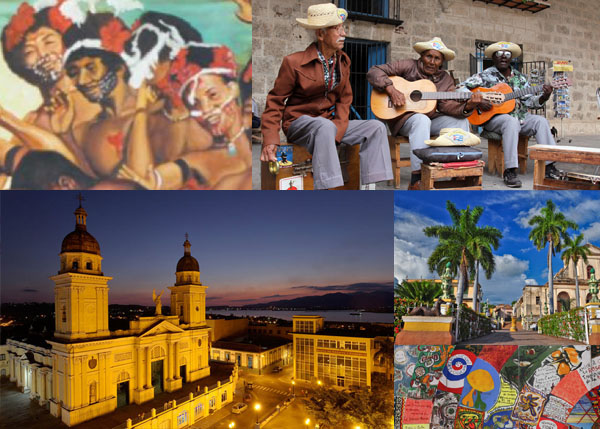9.17.1 Graciano Gómez Vargas.

Graciano Gómez Vargas, a prominent Cuban troubadour, composer, flautist, and guitarist, was born on February 28, 1895, in Havana. He inherited his musical talent from his paternal uncle, who was a singer and guitarist. At the age of fourteen, as a student of Máximo del Castillo, he began taking flute lessons; he later continued his musical training on the guitar with maestro Ramón Donadio.
When Graciano was seventeen, he played guitar alongside notable troubadours such as María Teresa Vera, Oscar Hernández, and Manuel Luna. Like his father, he was a cigar maker by trade; he worked as an operator in several cigar shops, including El Águila de Oro, La Flor de Todo, and Romeo y Julieta, alternating between playing music.
Graciano Gómez formed his first duo with Santiago Small, known as El Americano. With them, he performed at the restaurants Dos Hermanos, Mar y Tierra, and Vista Alegre, among other venues.
As a singer with the Curbelo Orchestra and the duo Los Americanos, in 1920, he attended the opening of the Italian cabaret-restaurant Lido-Benice. The following year, Graciano traveled to Miami with the Navy Band and the Cuban Troubadour Quartet.
Another group that Graciano Gómez Vargas formed was the Selecto Quintet in 1931; in this group, he shared roles with Isaac Oviedo, Rolando Scott, Juan Cisneros, and Zafir Palma, who was replaced by Barbarito Diez, a singer just beginning his artistic career.
Later, he founded Septeto Matancero. He toured countries such as Puerto Rico, Haiti, Santo Domingo, Jamaica, and the United States. He also participated in the group’s recordings for RCA Victor, and due to their notable success, they entertained with their music at parties held at the Vedado Tennis Club and the distinguished Country Club.
The lyrics of his songs addressed themes such as passionate love, the sorrows of the soul, and his beloved homeland, Cuba. In his work as a composer, he set to music verses by Gustavo Sánchez Galárraga, Miguel Eladio Casanova, José del Carmen Velazco, and José Sanjurjo.
His pieces have always been added to the repertoires of valuable performers, among whom we can mention Pablo Quevedo, who introduced several of his songs (Corazón perdona, La vieja herida, Flor criolla, La mujer de nadie).
As a composer and performer, Graciano cultivated all musical genres, from Bambuco, Son, Conga, Pregón, Rumba, Bolero, to Afro Music.
He participated in the first broadcasts of the Cuban Telephone Company radio station, along with Floro Zorrilla’s quartet, and is thus considered the founder of radio in Cuba. He also participated in the inauguration of Radio Salas.
Throughout his artistic career, he performed alongside renowned Cuban musicians, including Sindo Garay, Manuel Corona, Ernesto Lecuona, Rita Montaner, and María Teresa Vera.
Graciano Gómez Vargas died on May 22, 1980. He is considered one of the most important figures in the Cuban songbook and one of the most important troubadours in Cuban music.
Among his pieces are Afro Music: Querendengue; Sengue yaya; Criollo jaragán; Remembrance of traditions; Andumba, Congodumba.
The bambuco: Flowers. Guajiras: Tropical cadence; Idyll of the palm grove; Habanera come; The guajira of the Matanzas man; Cuban brushstrokes; Dawn; Cuban longing; That’s my guajira; Guajira illusion; Guajira complaint. Guajira-son: Idyll of the palm grove.
Bolero: False; Let me dream; Doubt and vagueness; In intimacy; It is sincerity; Every day I like you more; Appointment in darkness; Goodbye forever; Let me dream; I must always wait for you; Aesthetics; That which you want; Let me dream; Elodia; In your arms; Still waiting; I swore to love you; The song that is not sung; Against destiny; Heart, forgive; Nobody’s woman; The girl of the dovecote; Beautiful, if I could give you a kiss; But, wait a little; My love is like this; My happiness; My lost faith will never return; My prayer of love; My Saint Barbara; Liar; You were born like this, One cannot live without hope; Never leave; You did not come again; Hate me; But it will not be today, nor tomorrow, nor the day after; That is why I say; Remember that one day; Follow your path; They are kisses and wounds; You finally decide; I like you; Women’s vices.
Bolero-Son: When will it arrive?; Current Toy; Empanadas, text: Carlos Serrano Pérez; Beautiful; Crazy; Girl from the North; What should I do without you?; Laughing while crying; Keep going. Bolero-mambo: Let me taste your kisses. Moorish Bolero: Don’t look at me, gypsy.
Conga: The troupe is about to pass; The conga in society; The conga dressed in tails; Witch conga; Give it as it is. Creole: For a light; Hey.
Song: With Lies and Reality; Favorite; Without Telling You Anything; Set a Moon; A Summer Night; And Let’s Speak Clearly, text: Aurelio M. Zulueta; Cuban Caprice; That Night; From Flower to Flower; Fatal Love; Figure; Illusion; Piano Lesson; Little Hand; Marieta; Martyrdom of Nena.
Proclamation: Ribbons of All Colors; The Florist; The Tomato Seller; Crunchy Peanuts; Cigarette Girl’s Proclamation; Souvenir of a Vendor.
Guaracha: How smart you are; Follow your path; I am axe and machete. Guaracha-son: To the Cuban woman; To a woman from Matanzas; Just like that; Oh, get up even; Oh, what’s wrong with her?; That’s nothing; Creole flower; Stop, he didn’t pay; Vitico went bankrupt.
Son: Come on, Creole jaragán; Where will they be from?; Flowers for Maceo and flowers for Martí; Olivia; What are we talking about?; Virgin of Charity; You tell me. Son-afro: That’s nothing; María Juana; Unknown muse; I’m going to tell a story. Son-guajiro: Tropical cadence.








